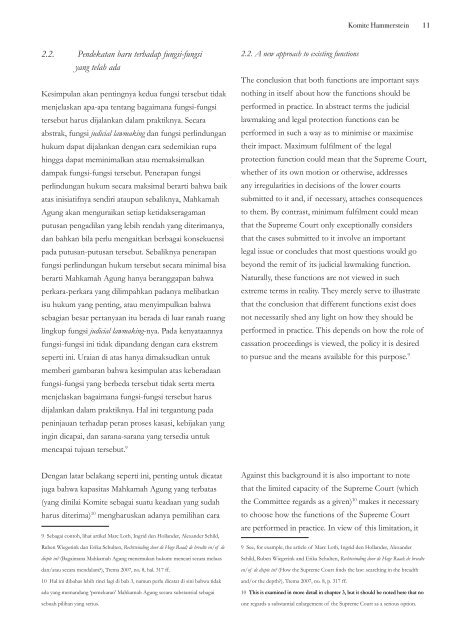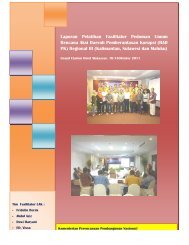Annex 1 - Selamat Datang di Direktorat Hukum dan HAM - Bappenas
Annex 1 - Selamat Datang di Direktorat Hukum dan HAM - Bappenas
Annex 1 - Selamat Datang di Direktorat Hukum dan HAM - Bappenas
Create successful ePaper yourself
Turn your PDF publications into a flip-book with our unique Google optimized e-Paper software.
2.2. Pendekatan baru terhadap fungsi-fungsi<br />
yang telah ada<br />
Kesimpulan akan pentingnya kedua fungsi tersebut tidak<br />
menjelaskan apa-apa tentang bagaimana fungsi-fungsi<br />
tersebut harus <strong>di</strong>jalankan dalam praktiknya. Secara<br />
abstrak, fungsi ju<strong>di</strong>cial lawmaking <strong>dan</strong> fungsi perlindungan<br />
hukum dapat <strong>di</strong>jalankan dengan cara sedemikian rupa<br />
hingga dapat meminimalkan atau memaksimalkan<br />
dampak fungsi-fungsi tersebut. Penerapan fungsi<br />
perlindungan hukum secara maksimal berarti bahwa baik<br />
atas inisiatifnya sen<strong>di</strong>ri ataupun sebaliknya, Mahkamah<br />
Agung akan menguraikan setiap ketidakseragaman<br />
putusan penga<strong>di</strong>lan yang lebih rendah yang <strong>di</strong>terimanya,<br />
<strong>dan</strong> bahkan bila perlu mengaitkan berbagai konsekuensi<br />
pada putusan-putusan tersebut. Sebaliknya penerapan<br />
fungsi perlindungan hukum tersebut secara minimal bisa<br />
berarti Mahkamah Agung hanya beranggapan bahwa<br />
perkara-perkara yang <strong>di</strong>limpahkan pa<strong>dan</strong>ya melibatkan<br />
isu hukum yang penting, atau menyimpulkan bahwa<br />
sebagian besar pertanyaan itu berada <strong>di</strong> luar ranah ruang<br />
lingkup fungsi ju<strong>di</strong>cial lawmaking-nya. Pada kenyataannya<br />
fungsi-fungsi ini tidak <strong>di</strong>pan<strong>dan</strong>g dengan cara ekstrem<br />
seperti ini. Uraian <strong>di</strong> atas hanya <strong>di</strong>maksudkan untuk<br />
memberi gambaran bahwa kesimpulan atas keberadaan<br />
fungsi-fungsi yang berbeda tersebut tidak serta merta<br />
menjelaskan bagaimana fungsi-fungsi tersebut harus<br />
<strong>di</strong>jalankan dalam praktiknya. Hal ini tergantung pada<br />
peninjauan terhadap peran proses kasasi, kebijakan yang<br />
ingin <strong>di</strong>capai, <strong>dan</strong> sarana-sarana yang terse<strong>di</strong>a untuk<br />
mencapai tujuan tersebut. 9<br />
Dengan latar belakang seperti ini, penting untuk <strong>di</strong>catat<br />
juga bahwa kapasitas Mahkamah Agung yang terbatas<br />
(yang <strong>di</strong>nilai Komite sebagai suatu keadaan yang sudah<br />
harus <strong>di</strong>terima) 10 mengharuskan a<strong>dan</strong>ya pemilihan cara<br />
9 Sebagai contoh, lihat artikel Marc Loth, Ingrid den Hollander, Alexander Schild,<br />
Ruben Wiegerink <strong>dan</strong> Erika Schulten, Rechtsvin<strong>di</strong>ng door de Hoge Raad; de breedte en/of de<br />
<strong>di</strong>epte in? (Bagaimana Mahkamah Agung menemukan hukum: mencari secara meluas<br />
<strong>dan</strong>/atau secara mendalam?), Trema 2007, no. 8, hal. 317 ff.<br />
10 Hal ini <strong>di</strong>bahas lebih rinci lagi <strong>di</strong> bab 3, namun perlu <strong>di</strong>catat <strong>di</strong> sini bahwa tidak<br />
ada yang meman<strong>dan</strong>g ‘pemekaran’ Mahkamah Agung secara substansial sebagai<br />
sebuah pilihan yang serius.<br />
2.2. A new approach to existing functions<br />
The conclusion that both functions are important says<br />
nothing in itself about how the functions should be<br />
performed in practice. In abstract terms the ju<strong>di</strong>cial<br />
lawmaking and legal protection functions can be<br />
performed in such a way as to minimise or maximise<br />
their impact. Maximum fulfilment of the legal<br />
protection function could mean that the Supreme Court,<br />
whether of its own motion or otherwise, addresses<br />
any irregularities in decisions of the lower courts<br />
submitted to it and, if necessary, attaches consequences<br />
to them. By contrast, minimum fulfilment could mean<br />
that the Supreme Court only exceptionally considers<br />
that the cases submitted to it involve an important<br />
legal issue or concludes that most questions would go<br />
beyond the remit of its ju<strong>di</strong>cial lawmaking function.<br />
Naturally, these functions are not viewed in such<br />
extreme terms in reality. They merely serve to illustrate<br />
that the conclusion that <strong>di</strong>fferent functions exist does<br />
not necessarily shed any light on how they should be<br />
performed in practice. This depends on how the role of<br />
cassation procee<strong>di</strong>ngs is viewed, the policy it is desired<br />
to pursue and the means available for this purpose. 9<br />
Against this background it is also important to note<br />
that the limited capacity of the Supreme Court (which<br />
the Committee regards as a given) 10 makes it necessary<br />
to choose how the functions of the Supreme Court<br />
are performed in practice. In view of this limitation, it<br />
9 See, for example, the article of Marc Loth, Ingrid den Hollander, Alexander<br />
Schild, Ruben Wiegerink and Erika Schulten, Rechtsvin<strong>di</strong>ng door de Hoge Raad; de breedte<br />
en/of de <strong>di</strong>epte in? (How the Supreme Court finds the law: searching in the breadth<br />
and/or the depth?), Trema 2007, no. 8, p. 317 ff.<br />
Komite Hammerstein<br />
10 This is examined in more detail in chapter 3, but it should be noted here that no<br />
one regards a substantial enlargement of the Supreme Court as a serious option.<br />
11




